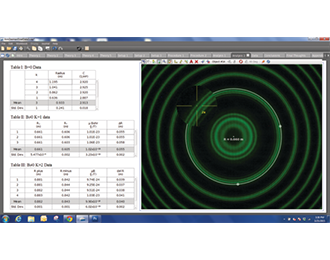Description
In this experiment the student observes the interference pattern form a Fabry-Perot interferometer which results from a 546.1 nm spectral line of a mercury lamp immersed in a uniform magnetic field. The magnetic field is varied from zero to nearly 1 Tesla.
Initially, the light is viewed along an axis perpendicular to the magnetic field axis. A polarizer is used to show the three lines due to light that is polarized parallel to the field axis and to show the six lines that are polarized perpendicular to the field axis. The pattern may also be viewed along the field axis where the light is circularly polarized.
Finally, the pattern that is polarized perpendicular to the field axis is used to calculate the Bohr magneton. All atomic magnetic moments are integral or half-integral multiples of the Bohr magneton.
PASCO Advantage: In PASCO Capstone software, students can use the video magnifier tool to enlarge the region to see the details of the line splitting. Also, the radius tool needs only three points to define the circle, so even rings that are partially out of view can be measured.
Experiments
Concepts
- Measure the Zeeman Effect with polarization perpendicular and parallel to the field
- Observe the light along the magnet axis
How It Works
In PASCO Capstone software, students can use the video magnifier tool to enlarge the region to see the details of the line splitting. Also, the radius tool needs only three points to define the circle, so even rings that are partially out of view can be measured.
What’s Included
- 1x Electromagnet
- 1x Power Supply
- 1x Optics
- 1x Magnetic Field Meter (SE-7579B)
- 1x PASCO Capstone Single User License (UI-5401)
Product Specifications
| CMOS Camera and Lens | 1/3″. 2M pixels, f=50 mm, RA=1.4 |
| Fabry-Perot Interferometer | λ=546.1 nm |
| Interference Filter | λ=546.1 nm |
| Collimating Lens | f=125 nm |
| Mercury Lamp | 10 mA, 3W |
| Electromagnet | 4A, 1T |
| Tunable DC Power Supply | 110V/220V, 6A |
| Precision Kinematic Optical Mount | Φ45 mm, 2D |
| Horizontal Optical Mount | Φ45 mm, travel = 36 mm, 3D |
| Track Length | 600 mm |


